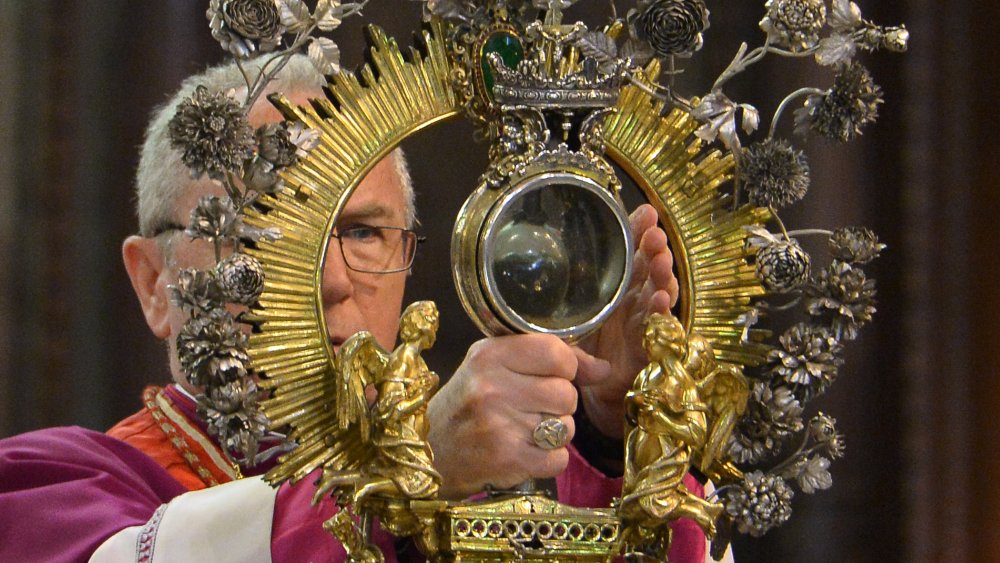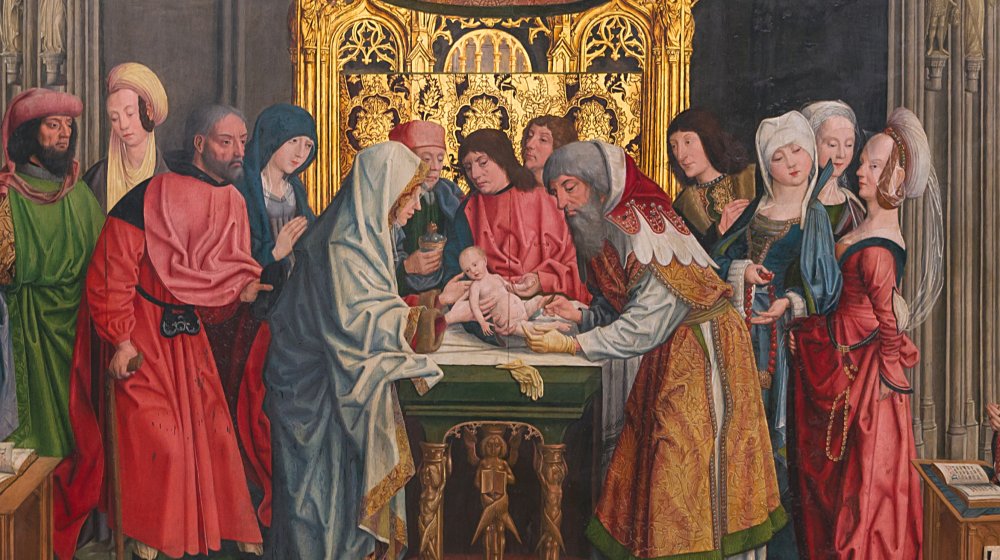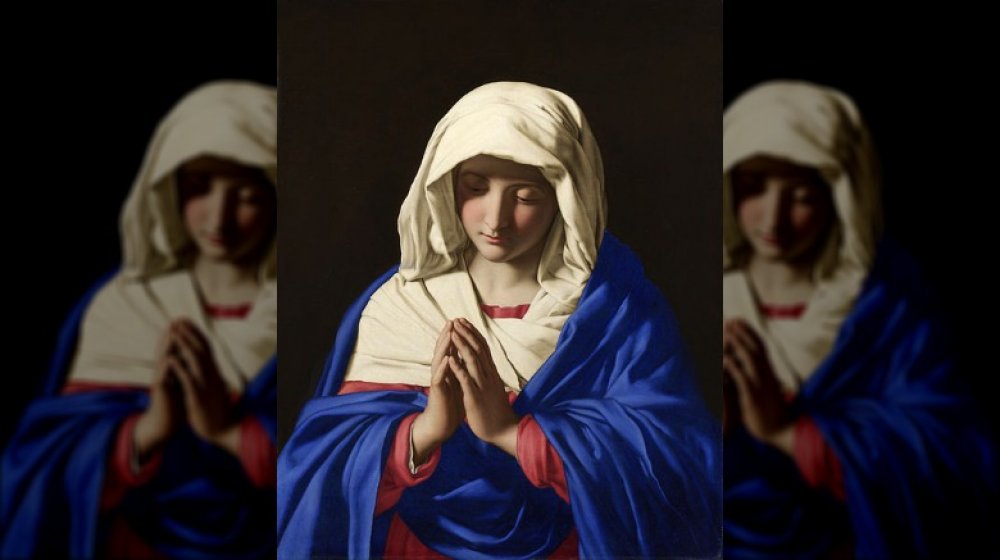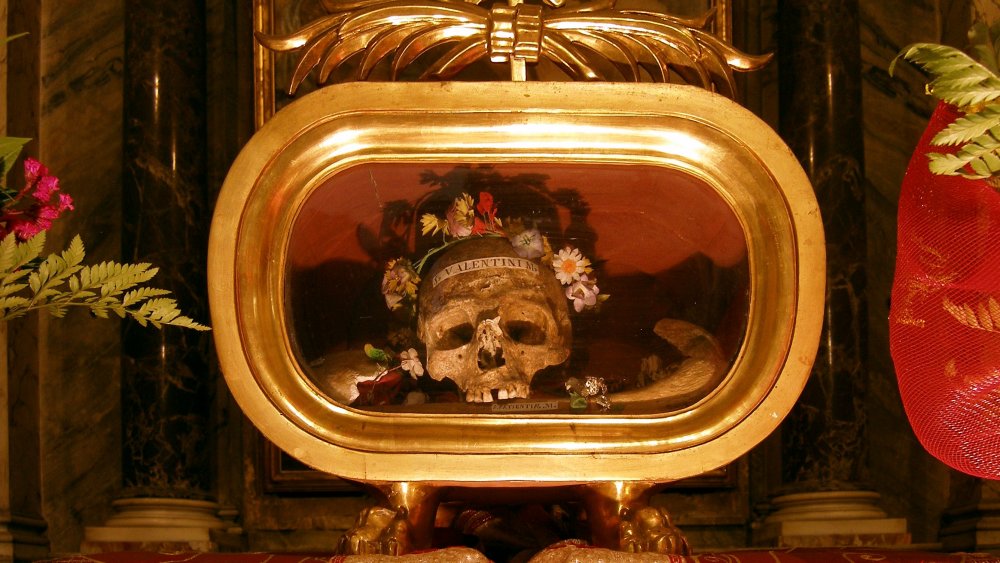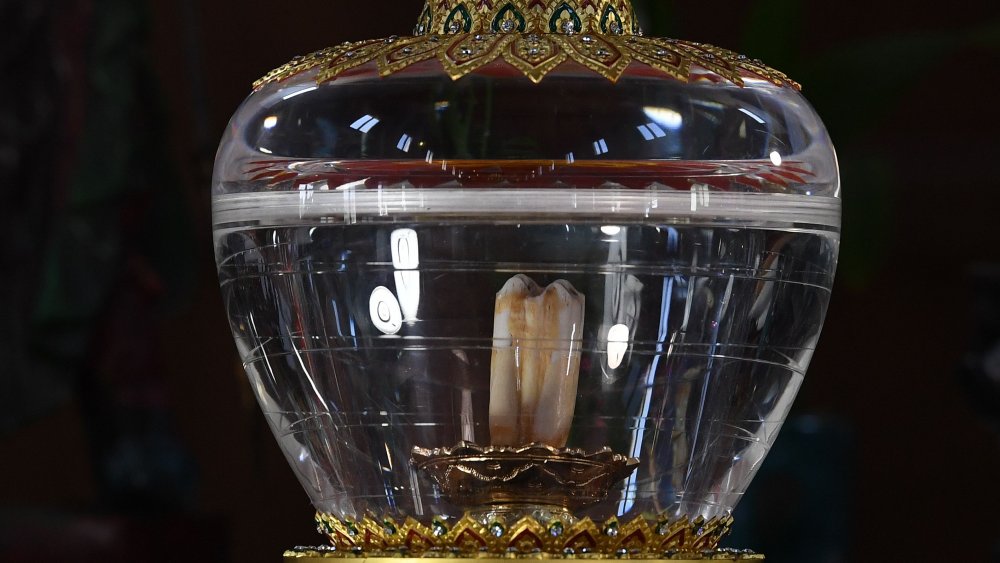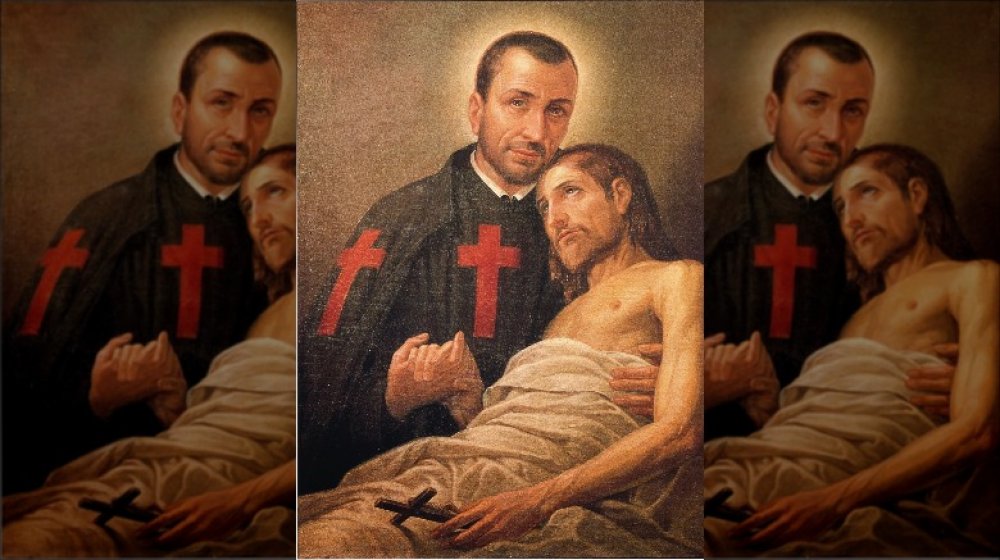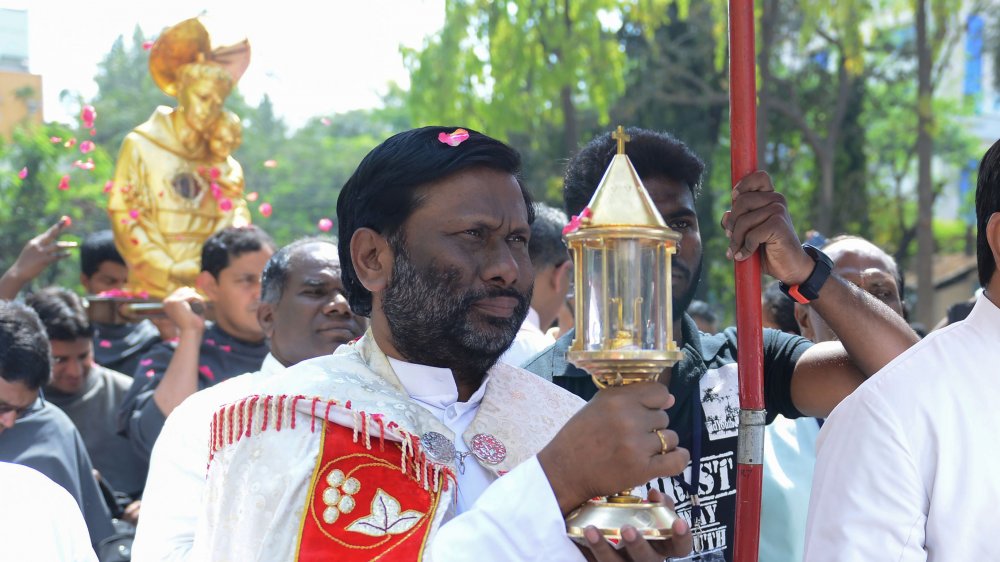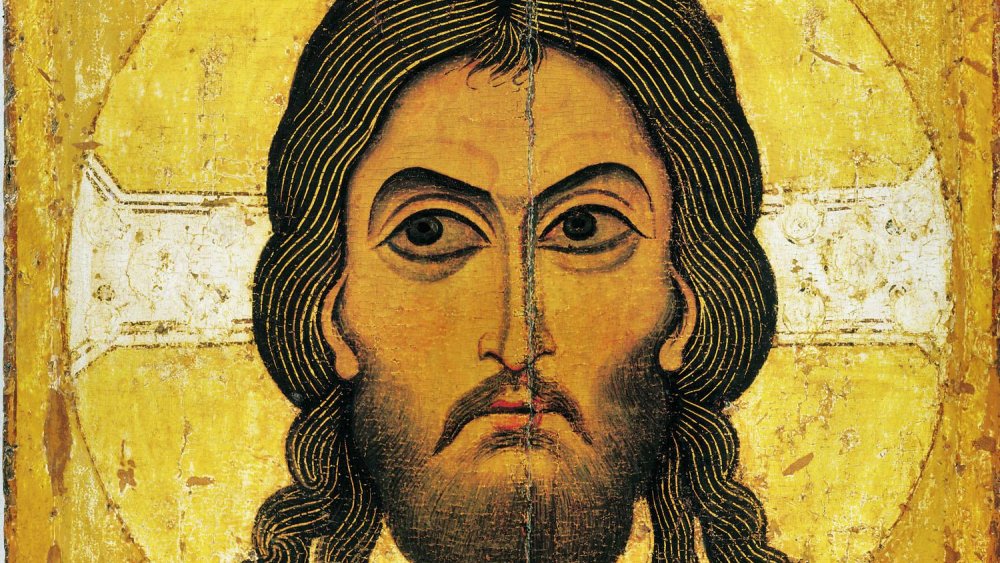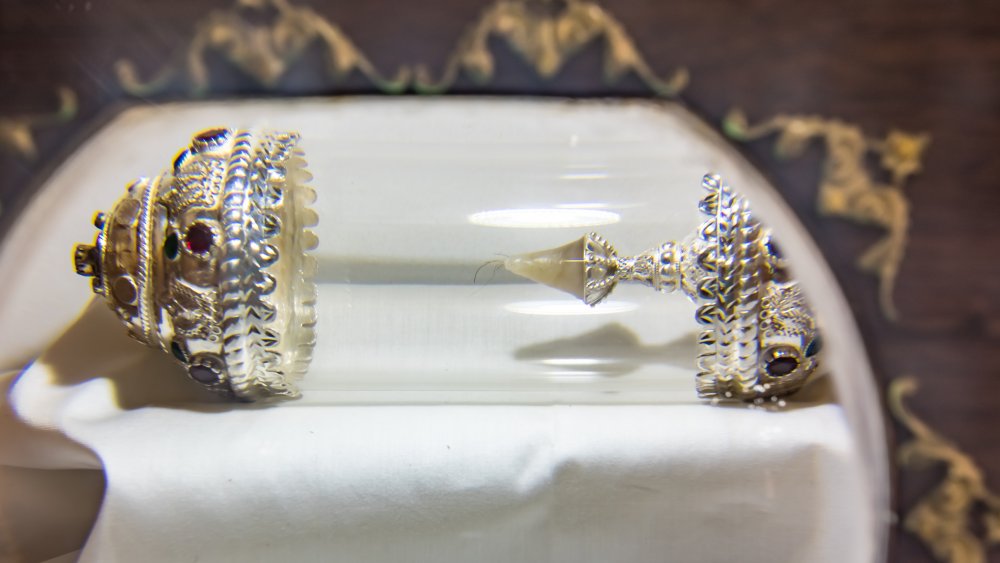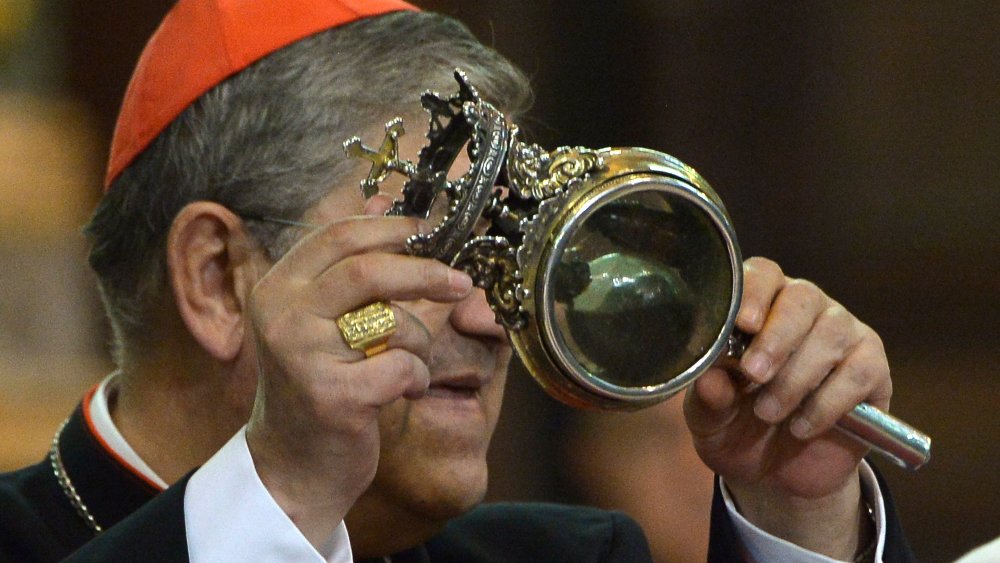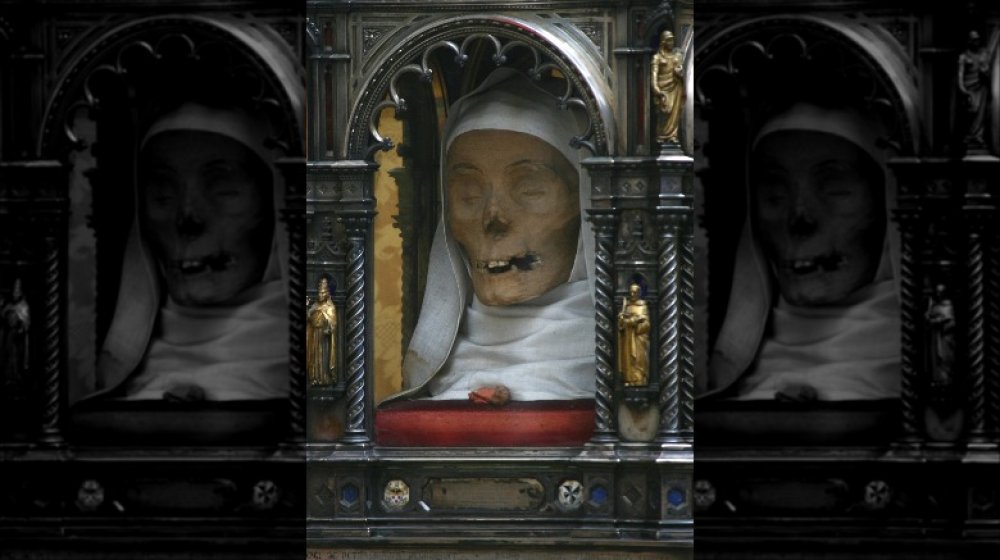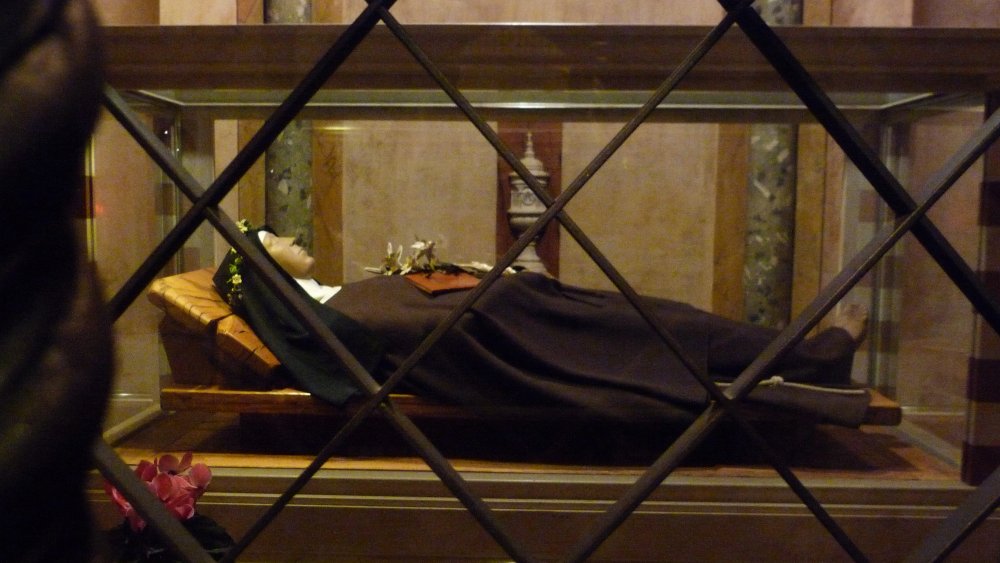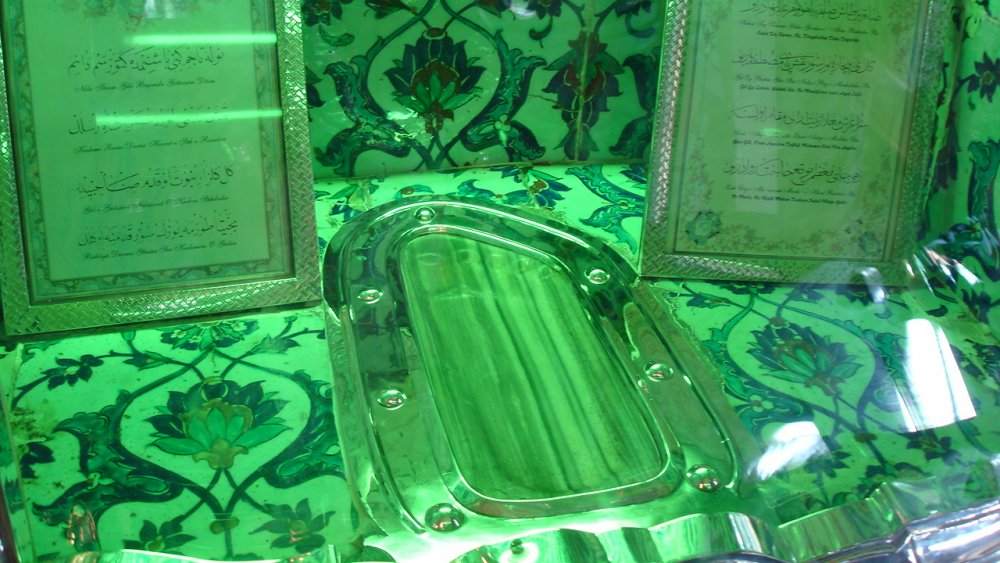The World's Most Fascinating Religious Relics
Within the world of religion, relics are either the personal belongings or surviving body parts of a saint or other notably holy person. Sometimes a relic can just be an item that people are reasonably sure the holy person in question has touched. These objects are often placed in a shrine or similar facility where the faithful can come worship, venerate, or snap an Instagram of them. While Christianity, with its abundance of saints, certainly has other religions outpaced in terms of quantity, it's by no means the only faith with important relics. Buddhism, Hinduism, and Islam are just a few of the religions that feature such venerated objects as an aspect of their worship.
But while some relics are the obvious things you might expect — nails said to be from the Crucifixion, bits of the True Cross, Jesus' burial shroud — many of them are weirder, grosser, or otherwise more fascinating than you might've guessed. Sometimes a relic is just a bone or just a box of bones or just a building full of bones, but here are some examples of times when a relic is something a little stranger than expected.
The controversial Holy Prepuce, foreskin of the Lord
As you might be aware, despite Jesus lending his name to a different religion of some renown, he was Jewish. You might also be aware that there's a certain medical procedure that Jewish people are famous for performing on baby boys when they're eight days old. If you've ever considered these two ideas at the same time, you might have asked yourself, "Hey, what happened to, you know, the part that got cut off?" Medieval Christians definitely asked this question, which led to the veneration of the utterly bizarre and controversial relic known as the Holy Prepuce.
As Wired explains, around the year 1500, the Prepuce popped up in the town of Calcata, Italy, and immediately began performing miracles, like issuing forth a perfume-like fragrance and stopping storms. Blind people who rubbed it on their eyes could see again (but at what cost?). Pilgrims flocked to Calcata to see it, and imitators popped up here and there. Unfortunately (?), the miraculous flap of skin was reported stolen in 1983, and it hasn't been seen since. Of course, there are those who argue that the Prepuce could never have been authentic, as every bit of Jesus would've gone up to Heaven with him following the Ascension, and an unconfirmed source claims that a 17th-century Vatican librarian said the Prepuce went up to Heaven and became the rings of Saturn.
The milk of the Virgin Mary
Relics of the Virgin Mary are surprisingly rare, but in the Middle Ages, one relic of the Blessed Virgin was surprisingly common: her breast milk. Containers claiming to contain the fluid that nursed the Son of God were so common, in fact, that Reformer John Calvin said in a treatise about relics that "even if [Mary] had been a cow her whole life, she could not have produced such a quantity."
One notable miracle involving the Holy Mother's Milk was known as the Lactation of Saint Bernard, in which a vision of Mary appeared to 12th-century monk Bernard of Clairvaux (not a big, drooling dog, alas) and shot a stream of milk into his mouth like a Super Soaker, which either granted him wisdom or cured an eye infection. A miracle more accessible to the public can be attained at the shrine of the Milk Grotto, just outside Bethlehem. Legend has it that Mary spilled a drop while nursing, which turned the stone there white, and now hopeful mothers mix bits of the soft, chalky walls of the grotto with their food, hoping it will help them conceive. This "milk powder" is available to visitors of the chapel (not online, alas), and the shrine bears countless letters and baby pictures from former pilgrims attesting to the efficacy of Mary's milk as a fertility aid.
The morbidly romantic skull of Saint Valentine
Despite being one of the few saints to have feast days known to non-Catholics (Saint Patrick being another notable case), practically nothing is known about Saint Valentine. In fact, there are three Saint Valentines, any of whom might be the guy whose decapitation we celebrate with romantic dinners every February 14 and with discount chocolates every February 15. And while a number of legends have been created to justify his association with romantic love, the fact is, we probably devote that day to love because that was the day Geoffrey Chaucer thought birdies did the dirty, in his poem "The Parliament of Fowls."
Anyway, only adding to the confusion is the fact that there are — as Atlas Obscura attests — no fewer than ten places that claim to be the home to the relics of the Saint Valentine. Of these, however, the one that best blends the Sanrio and Goth aesthetics you might imagine when you think "Saint Valentine, but dead" is the flower-wreathed skull found in Rome's Basilica di Santa Maria in Cosmedin. In case there's any doubt whose floral headbone you're looking at, his name is helpfully written across his forehead. As an added bonus, this same church is also home to the famous Mouth of Truth, which will bite your hand off if you tell a lie. See a cute skull, lose a hand — a truly an eventful day in the Eternal City.
The ever-expanding tooth of the Buddha is freaky, fascinating relic
While Catholicism definitely has the most in the way of relics, it doesn't have a monopoly on the concept. There are, in fact, a number of relics said to be the mortal remains of Siddhartha Gautama, the spiritual teacher better known as the Buddha. These relics include a hair that's supposed to have been Buddha's that moves on its own, as well as 10,000 colored crystals said to have been sifted out of his cremated remains.
But perhaps the most popular relic of Buddha is his tooth, which many different sites claim to have the only authentic example of, as it's supposed to be the only thing that remained after his cremation (not counting thousands of crystals, apparently). One such tooth reported on by NBC Los Angeles is inhumanly large and reportedly continues to grow long after Buddha's death. It also apparently radiates light, emits a beautiful fragrance, and attracts baby birds. Another relic claiming to be Buddha's left canine can be found in the Temple of the Tooth in Sri Lanka, and the one who holds this tooth is said to have the divine right of rulership. Naturally, wars were fought over it. Singapore likewise claims to have the real tooth and nothing but the tooth at its Buddha Tooth Relic Temple and Museum, a beautiful and elaborate tourist destination in Chinatown.
The charity-filled heart of Saint Camillus
Saint Camillus de Lellis was a 16th-century priest and nurse from Italy whose compassion for the sick caused a revolution in how we think about health care. He was known as "the Giant of Charity" and the concept that "the rights of the weak are not weak rights" is attributed to him. He founded a religious order called the Order of the Ministers of the Sick, aka the Camillians, who've continued to carry on his work in the ensuing centuries. Camillus' own advice to his adherents was to put "more heart in those hands" when serving the ill. How, then, can we hope to preserve the empathy and compassion found in a heart like Camillus'?
Well, in this case, you literally preserve the heart. According to the homepage of the Camillian order (who should definitely change their name to the Camillianaires), the actual, physical heart of Saint Camillus — which was preserved in a box with herbs, like it was KFC chicken — has served as a visible sign for the metaphorical heart of its generous bearer, being described as like a beautiful ruby and admirably large. The infirmary in Rome where Camillus died was transformed into a highly ornate Baroque chapel where the heart is on permanent display, inside a glass casket surrounded by Doric columns and elaborately carved angels. From there, this four-chambered metaphor serves as an inspiration to pilgrims to tend to the poor and infirm.
The soft and supple tongue of Saint Anthony
Saint Anthony of Padua is venerated as the patron saint of lost things, to whom one prays when they're looking for, say, their keys or their phone that they stupidly left on silent. Perhaps ironically, following his death at age 35 in 1231, one thing that he lost was the majority of his body to the natural process of decomposition (this isn't always a given for saints). One thing that remained, however, was his lower jaw, tongue, and vocal cords, which — upon exhumation to move it to a new basilica 30 years later — were found to be incorrupt and just as (bleh) pink and wet as they were in his lifetime. This miracle was interpreted to be representative of his oratorical skill in life.
As Atlas Obscura explains, you can go see the various bits of Anthony's oral apparatus in Padua even today. The jawbone is kept inside a fancy head-shaped fishbowl display that kind of makes the bone look like a partially invisible skeleton astronaut from the Mayan Empire. Just below the jaw is a golden reliquary in which the tongue is housed, looking like the fanciest birdhouse ever assembled. Below the tongue is a more modern reliquary holding the saint's vocal cords. Hopefully pilgrims can pray to Saint Anthony to help them after they lose their lunch looking at his wet, incorrupt mouth parts.
Jesus' washcloth, the Mandylion
Perhaps the most famous relic among modern audiences is the Shroud of Turin. It's a linen cloth marked with the negative image of a man on it, which many claim is the burial cloth of Jesus, whose supernatural presence rubbed off on the shroud like Silly Putty pressed on newsprint. The Shroud, however, isn't the only bit of cloth with Jesus' face magically printed on it. It is, in fact, preceded by a relic known as the Mandylion, a strange-looking word that just means "towel." The Mandylion, also known as the Image of Edessa, is considered the first icon — that is, a sacred image for religious devotion. It's also one of the most notable acheiropoieta, which are miraculous artifacts not made by human hands.
As the Royal Collection Trust explains, the legend of the Mandylion says that Abgar, the king of Edessa, wrote a letter to Jesus asking him to heal him of leprosy. Jesus wrote back saying he had a lot going on at the moment, but that he would send a disciple when he had a minute. That disciple brought with him a washcloth on which Jesus had dried his face, leaving his holy visage indelibly printed on the cloth. The Mandylion, naturally, healed Abgar, but unfortunately, the Holy Face was lost when Crusaders sacked Constantinople in the 13th century. Nevertheless, the Orthodox Church still commemorates this important relic every August 16.
A box of Muhammad's beard hairs
Technically, there shouldn't really be relics of Muhammad, the great prophet of Islam. Not because he wouldn't have body parts or clothes or whatever to leave behind, but because venerating relics could easily be interpreted as idolatry by more strict-minded sects of Islam. (You might recall that Islam has a general prohibition against the depiction of sentient beings in art for this very reason, so you can imagine how much worse setting up a shrine celebrating Muhammad's shoe or whatever would be). That said, there are definitely relics of Muhammad. The veneration of relics in Islam actually predates the condemnation of them, so those who choose to seek them out are actually taking part in a longer tradition.
The relics of the prophet believed to be the most authentic are kept in a special wing of the Topkapi Palace in Istanbul. The palace contains such notable objects as Muhammad's battle standard, his swords, one of the teeth he lost in battle, and his sandals, which are a traditional source of blessing. However, as The New York Times reports, one of the more unusual relics to be found is a glass reliquary that houses Muhammad's beard. The story goes that the beard was shaved from the prophet posthumously by his favorite barber, Salman the Persian, in the presence of witnesses who testified to the hairs' authenticity.
The bubbling blood of Saint Januarius
Almost nothing is known about the life of Saint Januarius except that he was a bishop in Italy who was martyred, possibly during the persecution of the emperor Diocletian in the early days of the fourth century CE. What is known is the popular ritual carried out multiple times a year in Naples, in which Januarius' 1700-year-old blood turns liquid and starts to bubble when brought close to his skull.
According to the Catholic Encyclopedia, the saint's dried and congealed blood is kept in two glass vials inside a silver reliquary. At three points in the year, including the saint's feast day (which, somewhat unexpectedly, is not in January), a silver head said to contain the skull of Januarius is placed on an altar, and the vials of blood are brought out of the bank vaults where they're kept the rest of the year. When the vial is brought near to the skull, the previously solid blood sludge turns liquid, usually instantly but sometimes taking days, which is celebrated with a 21-gun salute and crowds of people kissing the miracle blood jar. Instances when the blood fails to liquefy are thought to herald great catastrophe, like the beginning of World War II in 1939, a disastrous earthquake in 1980, and, well, we all know what 2016 was like.
The severed head of Saint Catherine of Siena is one disturbing relic
Saint Catherine of Siena began seeing visions of Jesus at age seven, and by the time she was a teen, she'd pledged herself to perpetual virginity, cutting off her hair and entering a nunnery in order to avoid potential suitors. Soon afterward, she had a vision of the only boy she would ever love, Jesus, visiting her and giving her a wedding band as a sign of his love. This wedding band, however, was no boring ring of gold. Catherine's ring was made of the Holy Prepuce, aka the Baby Jesus's excised downstairs skin. Catherine claimed for the rest of her life that she could see this ring on her finger, though it remained invisible to everyone else. Later, she received the stigmata when a crucifix shot lasers at her.
Such a remarkable woman deserves a remarkable relic, and indeed, she got one. If you wanted to see Saint Catherine's entire dang head in a fancy box, you are in luck. As Atlas Obscura explains, the head — which was smuggled back to the saint's hometown in a paper bag via a miracle in which the severed head turned into rose petals when guards looked inside — is available for pilgrims to visit in Saint Dominic's Basilica in Siena, Italy, with a smaller reliquary containing her right thumb (alas, not her ring finger swathed in Jesus skin) placed nearby.
Saint Clare's box of hair and glass of fingernails
Saint Clare of Assisi was the protege of the famous Francis of Assisi, but she was an accomplished saint in her own right. Born to a noble family in the late 12th century, Clare spurned earthly wealth to join her friend Francis in a life of pious poverty. As a symbol of her renouncing worldly concerns, Francis cut off Clare's legendarily beautiful hair and dressed her in rough sackcloth. Soon, Clare was founding her own religious order — the Poor Clares, still active today — and performing such miracles as driving off a whole army of Saracens using nothing but a communion wafer. In 1958, she was named the patron saint of television because of a miracle in which she was granted a vision of Christmas mass from miles away while bedridden with illness.
As Sacred Destination explains, the Basilica of Saint Clare in Assisi contains a number of relics that would be of interest to any Clare stans out there, including a crucifix that once talked to Francis and a crypt with Clare's entire body preserved in wax. Near the tomb is a display of other relics including a box full of Clare's hair that Francis cut off and a shirt she made. If a box of hair isn't enough to heeby your jeebies, don't worry. There's also a crystalline flask filled with Clare's fingernail clippings.
The footprints of the prophet Muhammad are fascinating relics of sasquatchian proportions
Generally speaking, relics are, you know, things. They're bones or blood or scraps of cloth or bits of wood. Things you could, theoretically, hold in your hands but that you'd definitely get in trouble for holding in your hand. It's not often that a relic is the, like, absence of a thing. It would be, for example, very difficult to say that your church had the hole that dreamcoat Joseph was thrown into by his brothers before they sold him into slavery. And yet, one of the potentially many things that the prophet Muhammad has in common with the sasquatch is that the most common evidence of his presence is something intangible: footprints. And based on the casts made of those footprints, another thing the two have in common is extremely large feet.
As explained in the journal Muqarnas, some Muslims believe that whenever Muhammad stepped on a rock, he left behind an indelible footprint. As such, there's no shortage of shrines dedicated to these foot-shaped imprints throughout the world. For example, Topkapi Palace in Istanbul has one, and they can also be found at the Shrine of the Holy Footprint in Delhi, India, and at the Dome of the Rock in Jerusalem, among many other places.
